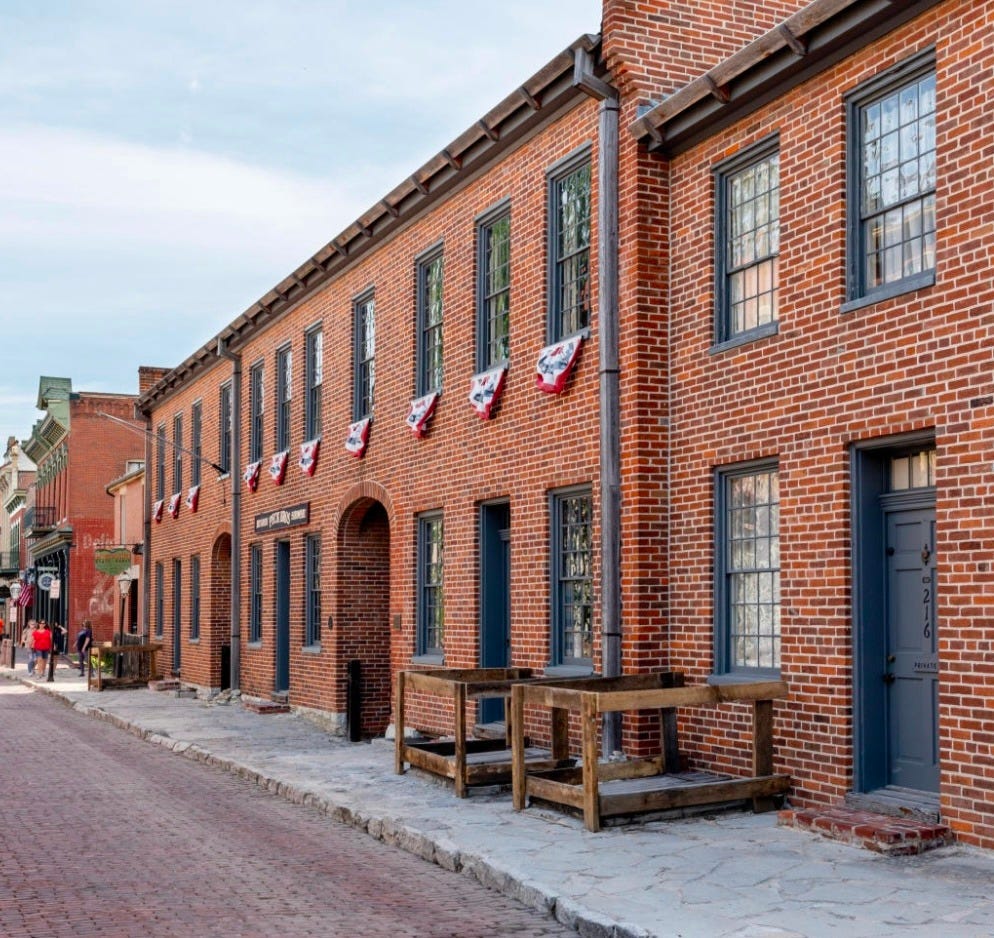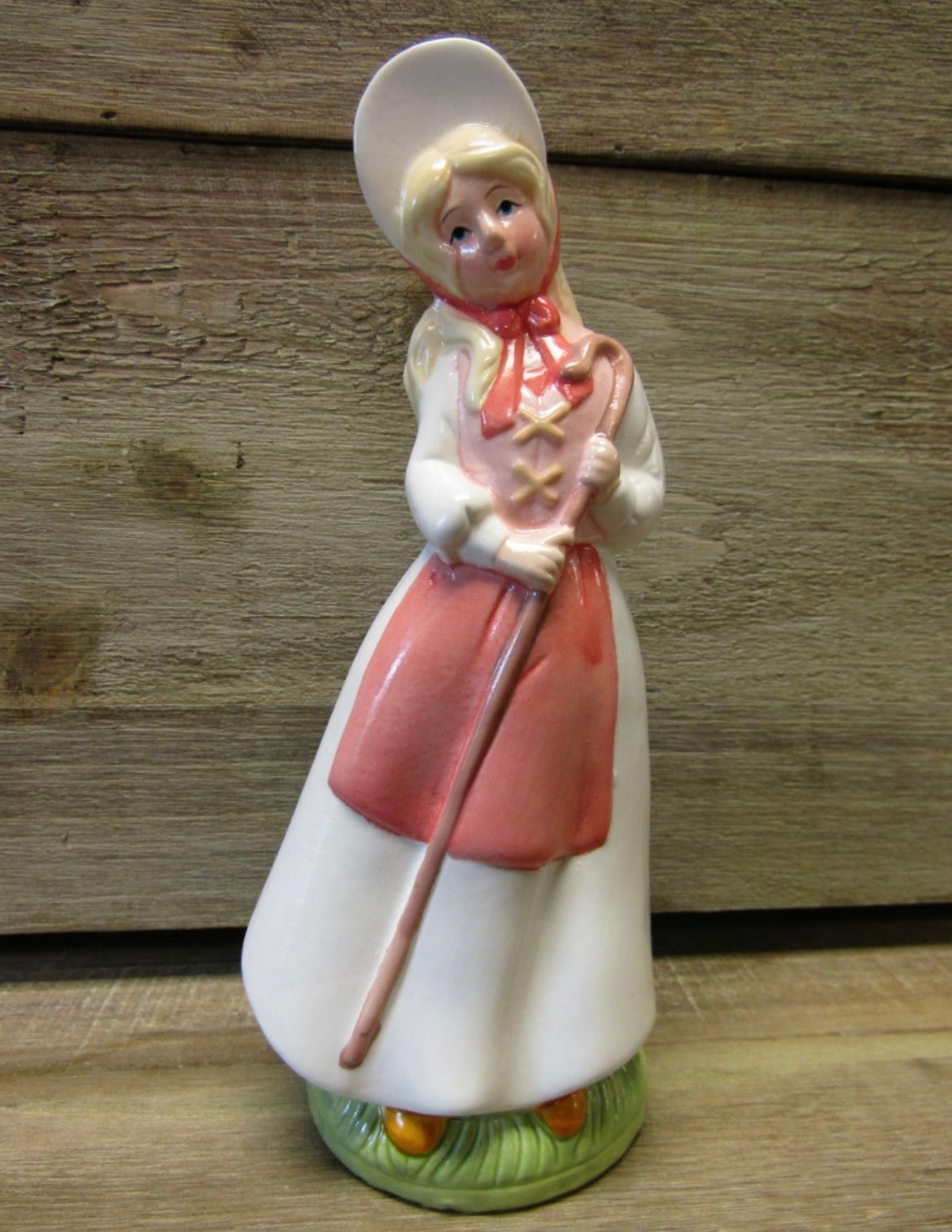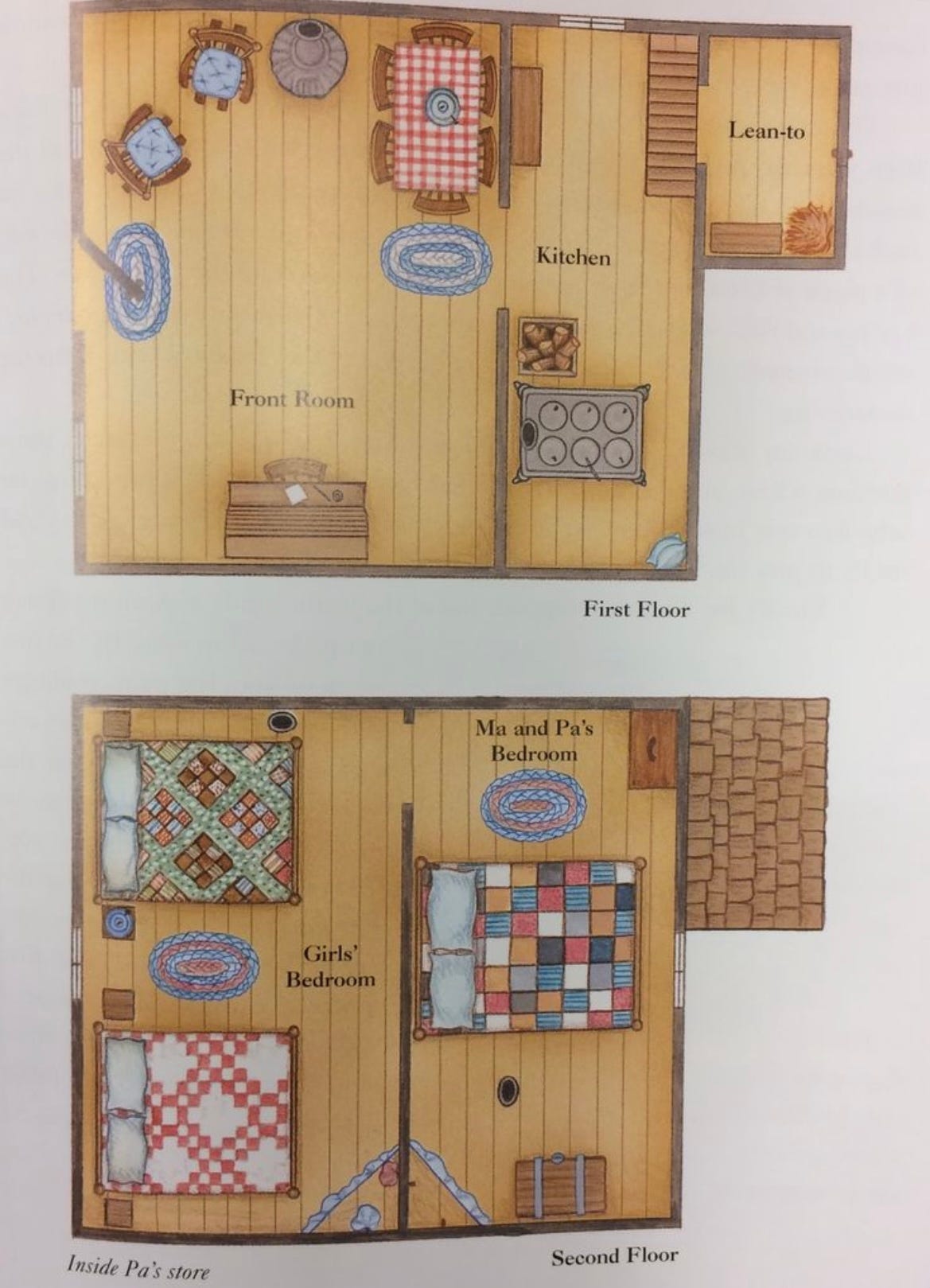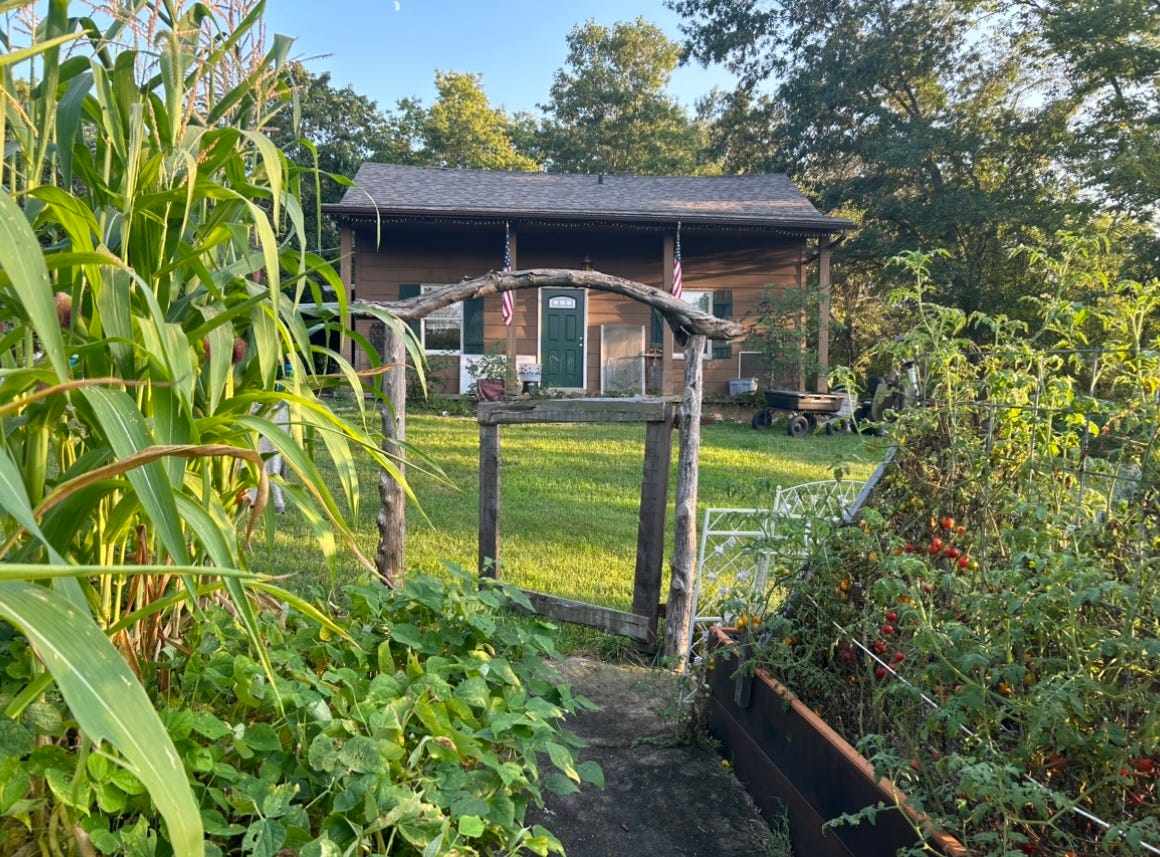Humble Homes, Full Nests
Examining the value of small houses and the frugality they inspire in the context of family building
When I tell people in the city hospitals I have worked in over the years where I live, the most often response I receive is “why do you live all the way out there?” “There” being about an hour south of the city, in a town no one really chooses to visit on purpose, in a 130 year old house that is pretty small, lacks a basement, and hadn’t been remodeled since the 1960’s when we moved in. The house had glitter in the popcorn ceilings when we moved in, orange shag carpet and that classic color scheme of dark, dark brown and dirty yellow. The last person who lived in it was a bachelor in his early twenties, and one could make this assumption easily just by looking around. There were shotgun shells all over the ground, burn barrels, beer cans strewn about everywhere you looked in the woods surrounding us. The house that was once a true farmhouse had become more of a frat house.
The answer to the question from my coworkers was this: “because we will actually be able to pay this house off before we’re old and our children are flown from the nest”. We got a great interest rate, the home itself was less than $90,000, and we have several acres. Those acres are part of an easement so the surrounding land is just forest and a couple of ag fields, which are downhill from us. We have a creek the kids can play in. We can explore in the woods and go treasure hunting in the multiple old barns that are slowly being overtaken by nature. My daughter’s friends and she like to do just that and they call it “antiquing” because they always dig up some sort of charming old treasure (perhaps only charming to them!). As far as the state of the home, my husband can fix most things, this is what he does for work and he has the tools to do so. Anything he can’t do, he knows someone who can.
And truly, I just love old houses. I do not think I would ever consider for even a minute living in a new build. I find them upsetting in the way I find the fluorescent lighting at department stores upsetting. I grew up in an old house with the creakiest wood floors you’ve ever heard, pretty French doors, and a coal room in the basement. It even had a laundry shoot, a childhood favorite. Living where we did, in an old river town, most all of my friends all lived in old homes. The main street has cobblestones and a storied past, and I will forever be grateful I did not grow up in the strip-mall, big box store, mega suburbs of the outer surrounding area.

The other night, I drove the hour to and the hour back from my parent’s house and on the way saw several newer neighborhoods where every single house had the same exact Christmas lights up. Not only were the lights the same (warm white, large bulbs, outlining the sharp lines of the houses), but the outlines they were attached to were the exact same as well. Que the “Little Boxes” song….only these are more like “Semi-Giant Boxes”. I suppose that that is the result of an HOA Christmas light dictatorship or something, but I just find it sad. There’s no colors, or silly Charlie Brown pop-up characters, or those vintage candy canes that swank the front walk. The homes are huge, they are HGTV-approved in terms of style, they are in good school districts, they have perfect landscaping and those lights that go under the windows and trees, and they are as boring as it gets. Not to mention the mortgages.

The irony of this is that some people will read this and tell me that I am able to live in an old house because of privilege. The privilege to have a husband, to have one that knows how to build things and fix things, who has those tools. To have bought my house when I did, before interest rates shot up. To own a home at all. To which I agree that these things are privileges. They also are just the result of paying attention and choosing wisely. For every way our home is a privilege, there is also a sacrifice. It is in these sacrifices that the treasure exists though. The peace of mind that we will always be able to afford our mortgage, the fact that it is well on it’s way to being paid off, the little bit of land we have and the food we are able to glean from it, the time we have together as a result of not having to work as much to afford a big house—these are the treasures.
At less than 1,500 square feet and with 5-going-on-6 humans living in it, we do not have a ton of extra space. We have to be very creative with storage and sleeping quarters. I have to really consider every single piece of furniture I choose to bring in to the home. The crawl space under the stairs has become the “play room” for lack of a better place to store toys (the kids love it, of course). I’m fine with a small house, I would find furnishing a larger home very overwhelming. I also think about some of those giant houses I have driven by and wondered how strange it must be to have your bedroom on one side of the house and not even be able to hear or know what is going on in the other parts of the house.
When homes are that large, it seems like the overarching theme is a sort of “autonomy within the home”. Everyone has their own special space catered just to them, no one has to share, and it is easy to drown out the happenings in other parts of the home. Obviously, quiet and privacy are commodities that are valuable, but I find that thought unsettling. I value a sense of coziness over a sense of autonomy-within-the-home.
Household interdependence is the concept my mind conceives of here. It is playing out as I write this, sitting at the kitchen table while my children feed beef jerky to their dinosaur figurines and ask me which monster in Moana was the scariest whilst I attempt to think straight. Most all tasks are done in the presence of others. Interruptions are plentiful, and explanations for the tasks are often requested. It can be frustrating and annoying, yet it means we are witnessing one another’s lives, and as such, one another’s brilliance. My children seeing me write and do research and my explanation as to why I am doing these things matters. Their watching of me baking and cooking, hanging and folding laundry, and sweeping the floor, and their inevitable participation means they are learning basic skills. If there was a basement playroom, or a real playroom at all, they would not be by my side learning and witnessing as they do. This also means I am better able to respond to their immediate needs, I have a fairly resilient ability to focus in the midst of chaos that has been honed, and I am similarly witnessing them in all of their silly, boisterous glory.
This does not only apply to small children though. I believe the same idea of witnessing everyday brilliance applies to the older members of the household as well. If my 13 year old is doing her homework close by as I cook dinner because the smaller children are being too loud close to her room, I am able to see and understand more of what she is learning, and listen to her stories of her days at school (which is new for us, as she was home schooled up until 7th grade). If my husband is working on a house project close by (and everything is “close by” in our house) while we are all at home together, I am better able to appreciate the hard work and resources that it takes for him to accomplish these things that enrich our lives within our little home, and vice versa. These things happen in all households of course, but within a smaller, humble house like ours, they are essentially non-optional and shape the way we relate to one another in an undeniable way.
I feel happy with a small home, but I become suddenly hyper-aware of the fact that I have some long instilled conditioning around the superiority of larger and newer homes when family or new people come to visit. I feel the eyes on the half-finished projects and wince a little. I wonder if they are judging the fact that everyone has to share space. I take in the comments about the absolute NEED for an addition in light of my latest pregnancy thinking to myself “do they really think I haven’t thought about this myself a million times already?”. I hope they don’t notice the crayon all over the baseboard that I myself just noticed.
Then, I wonder why I feel this way. Again, I grew up in an old house. I knew many people with small homes who had to share bedrooms with siblings. Not every house I have been to has been pristine and perfectly mopped and dusted and decorated to Chip and Joanna’s standards (are they even still cool? I don’t even know what the home decor standard is) and in the ones that I have been to, I felt slightly uneasy. The homes I enjoy visiting are the ones full of art and weird antiques and knickknacks, the ones that feel like little personal museums (see photo below, from one of my favorite IG accounts which showcases Eastern European homes, all of which are small and full of handmade handicrafts). The homes with family photos and preschool art, the homes with *collections* of all sorts, the homes a little bit frozen in time. When all of the artwork is from Hobby Lobby and Marshalls, I can feel the insincerity. And yet, I still must push through the cultural conditioning that none of us are immune to. Maybe it was all of the MTV “Cribs” I grew up watching, maybe it was all of the Pottery Barn catalogs that sat on the coffee table when I was a teen. Whatever it is, it lives there in my brain right alongside all the other insecurities I still hold, and I think it primarily has to do with the size of our growing family.
The average home size (this is from 2022) ranges by state, but in more than half of the USA, that size is over 2,000 square feet. The average size of a home has also gone up steadily over time. The size of the home we live in falls within the average square footage of the two bottom-most states in terms of house size. From Forbes, “The state with the least expensive housing market had a median price of $229,000 in September (of 2024), according to Redfin’s monthly housing data. The priciest was almost 3.5 times as much at $787,000.” The same article states that in 2023, the median home price was $412,000 in September of 2023. I realize these prices and the interest rates that come along with them are a lot of what makes home ownership feel impossible for people. I also understand that these sorts of figures are what inspires that attitude of “privilege” when it comes to home owners.
What is missing in this discourse is the idea of frugality and creativity. I look at Zillow all of the time, and the amount of homes with serious potential that also have at least 5 acres (one of my search filters) that are $200,000 or less is quite inspiring really. The issue is that many of them are more remote, many need lots of work, many are not perfectly aesthetically pleasing, and many would require some know-how and imagination. And perhaps it is just me, but those qualities are harder and hrder to come by.
It is perfectly reasonable to want a move-in ready home. It is perfectly reasonable to want a home close to your job. It is perfectly reasonable to not appreciate glitter ceilings and shag carpet. Along with those expectations though, are a set of sacrifices that are the opposite of my own. For families like my own, the ability to be home more and have more children are the priority. For this, we deal with minimal square footage and a lot of upkeep. For the average 2,000+ square foot, $400,000+ home owner though, the priorities are more in line with what is convenient and conventionally acceptable in terms of aesthetics. Convenience and acceptability do not require the same level of imagination nor know-how. Again though, this is just a matter of preferences and sometimes, geography.
People are entitled to their preferences and their conveniences and expectations, of course. From Census.gov, the average number of people per household in 2024 is 2.51, down from 3.33 in 1960. Similarly, the average amount of children under 18 in a home in 2024 sits at 1.94, down from 2.33 in 1960. Both of my parents were born in 1960, and the state of things has changed in many ways beyond just family size since then. There are many interesting and well thought out conversations as to how these changes in culture have contributed to the shrinking family size and what is to be done about the fertility crisis, this piece over at
being one of the best ones I have seen thus far. That is not my purpose with this essay, however. My purpose is to draw a connection between the value of a smaller, shabbier home and the value of a larger family in an society where homes are getting bigger and families are getting smaller and how these two things compliment and necessitate one another in today’s world.Growing up, my favorite stories to listen to my mother read were the ever-popular and now controversial Little House books. As a mother, they are some of my favorite books to read to my own children. Much of what makes them so appealing, I think, is how descriptive they are. The way Laura Ingalls Wilder describes the different craft work of Almanzo’s mother in Farmer Boy, for example, have stuck with me for years. Another enduring memory from my readings of the books were the details about how Pa Ingalls built the family’s many homes and how small they all really were. A few years ago, I purchased a copy of The World of Little House for my eldest daughter. Included in this book are floor plans of all of the houses in the Little House series.
Reading the books, I was always impressed by the skills that Pa possessed, the fact that he could literally build a home with nothing but hand tools and the materials that surrounded their plot of land felt almost God-like to me. Not only this, but then reading about how Ma decorated the home with household scraps, hanging calico curtains up with pieces of string and the like. The gritty ingenuity of necessity meant people came up with ways to keep a beautiful home despite a budget that did not allow for extras and sometimes even a geographical lack of access to any sort of shop with such extras. What small luxuries they did have, they cared for with such reverence that is rarely seen today in the age of the Youtube “haul video”. Ma’s china shepardess comes to mind.

Looking at those floor plans is a comfort to me. Whenever I get comments about the size of my home or family, I think about those little houses that not only the Ingalls family lived in back then, but most families. I think about the fact that child-me would have preferred a little house with many siblings over a giant house with none (neither of which match my upbringing, to be clear). I think about people throughout history and in current times in different places in the world that lived in and are living in more interdependent households.
To be fulfilled does not require a big house where everyone has their very own special retreat and where no one has to ever cooperate or compromise. To be fulfilled is to live by our means, in spaces that illustrate what we care about, with the people we love who we continually learn to compromise and cooperate with.
Living within our means is how we create the wealth that is not measured by money. The wealth that comes in the form of babies, of hobbies, of skills, of rest, of time. Frugality is freedom if you value time and energy and spaciousness, and what resources mean more to a mother? Time to both spend with your children and with yourself. Energy to expend while doing so. This makes prioritizing frugal decision making tantamount to our happiness. The value in small, humble homes lies in their power to create spaciousness in our lives for what we truly want to devote ourselves to. For me, that is children and family.
This makes me consider what “valuable" really means. To me, value is both something that adds and subtracts. Adds meaning and purpose and satisfaction and resources. Subtracts needless bleeding of finances and time wasting. When we invest in our skills in service of keeping a humble home and choose patience and humility over the need to keep up with social expectations, we are amplifying our personal impact and deducting extraneous demands from our lives. Those deductions make room for the multiplication that is flourishing fertility.

One of my favorite books"Radical Homemakers" by Shannon Hayes states
"Our culture has been hostage to a form of organization by domination that fails to honor living systems, where ‘he who holds the gold makes the rules.’ By contrast, Radical Homemakers use life skills and relationships as a replacement for gold, on the premise that he or she who doesn't need gold can change the rules. The greater our domestic skills, be they to plant a garden,... mend a shirt, repair an appliance ...the less dependent we are on the gold."
I do not want to be beholden to the keeper of the gold when it comes to my reproductive existence. I want to eliminate my need for that gold, and the best way I have found to do so is by taking on a mortgage that was below our means and paying extra every month. This means our house is small and in a constant state of “not finished”. It means I feel a little embarrassed sometimes even when trying to embrace “shabby hospitality”. It means I don’t get much privacy.
It also means that in lessening my dependence on the gold, I expand my interdependent relationships. Dependence is a give-in, what we need to pay attention to is to who we desire to be dependent on and in what way. Do we desire dependence on entities that are not truly interested in our well being on an intimate level? Or do we desire an ever-evolving give-and-take relationship of dependence between ourselves and our closest people?
In an America where houses and their prices are growing and the number of babies couples are having is shrinking, choosing a small, old, fixer-upper is the foundation for family building beyond the 1.94 children per couple that is the current state of reality.
If we expand our willingness to forgo some conveniences, we thus can expand our families. If we can be imaginative in the potential of that old, creaky, little house, we can be more imaginative in terms of what our families can become. If we can persevere to fix that old house via trial and error and learning new ways, we can also persevere through the trials that come with parenting and marriage. There is a lot to be said for a sense of domestic endurance. The question here really is one of priority and the capability to stay the long course.
The meaning and purpose attached to mothering my children is the real gold I am after. The space to have as many babies as my body and heart are able to handle is the sort of freedom I seek. There are many kinds of freedom and the sort of freedom that allows for ties to be made rather than cut is the kind that I find to be of the most value. In prioritizing this kind of freedom, many conveniences are left by the wayside. In prioritizing family building over home upgrading, we are making a different sort of investment.
I would rather be sitting at my little scratched up kitchen table in my little warm kitchen in my little shabby old farmhouse with my little children and one in my belly than in a giant beautiful kitchen in a giant beautiful house whose mortgage makes me fret every month and scares me away from having more children any day of the week anyhow.







Beautiful. I just moved with my second husband (I was widowed young with children) closer to his family. We picked a smaller home in an established neighborhood with mature trees. Originally, I had a hard time wrapping my head around it. Our previous house was newer and bigger. We drive by these huge mega-mansions every day. I sometimes feel the envy. But then I get home and I love where we live. I love that our mortgage allows my family to prioritize ministry as a career for my husband. I am a stay at home mom with a toddler and two tweens. I think about the lifestyle required to have one of those homes and say NO WAY. God Bless.
I dream of having a smaller house. Less to clean!!!!